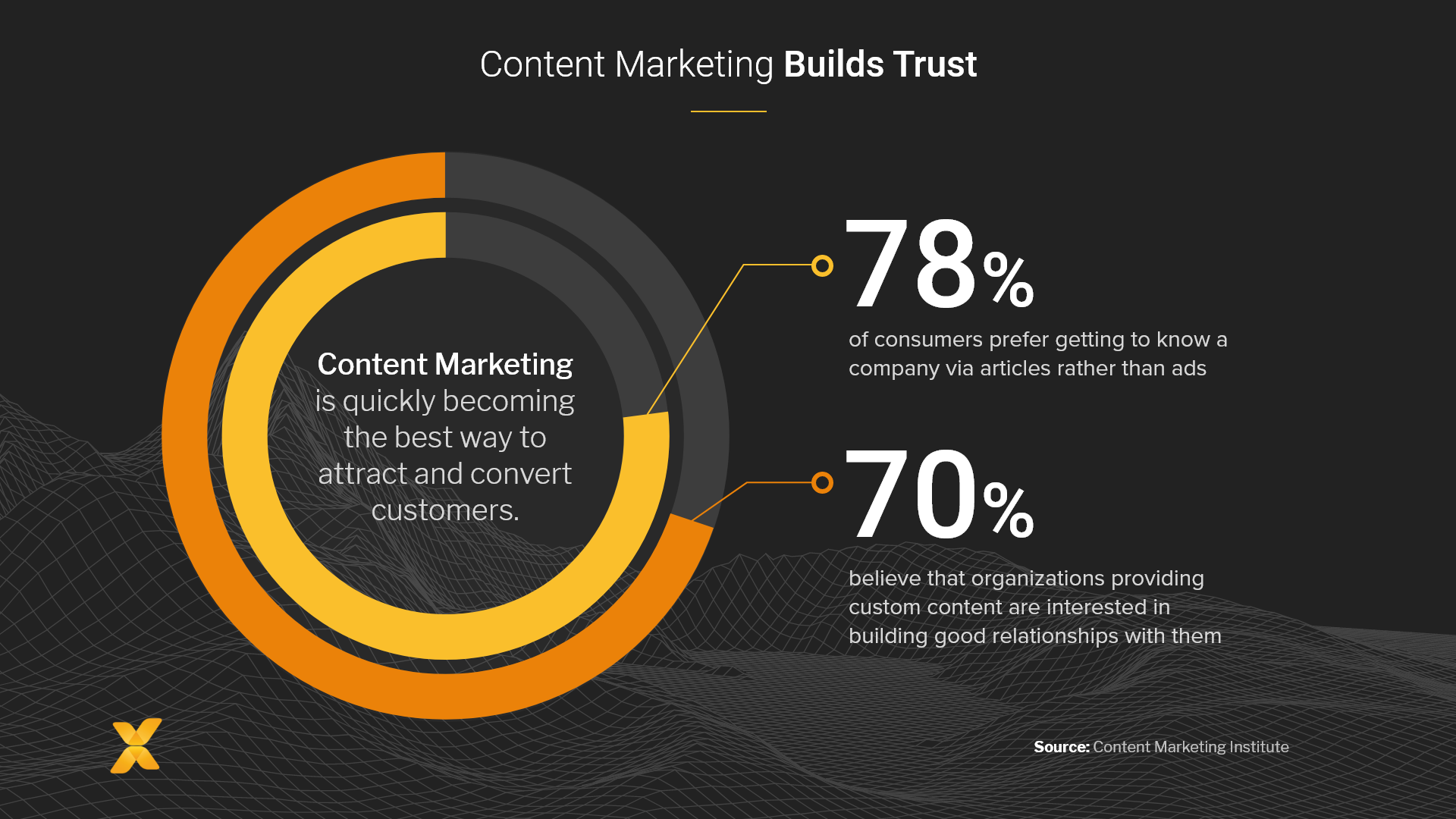Digitalization has profoundly changed the buying journey. It doesn’t matter if we’re talking B2C, D2C, or B2B; today, the buyers are holding the steering wheel and navigating the purchasing process. The days when brands and sales organizations could orchestrate the sales processes are long gone. Customers today have complete access to unlimited information about the market and alternatives at their fingertips.
TABLE OF CONTENTS
-
- Content-Led Commerce: The Right Content at Every Touchpoint
- Building a Content-Driven Brand Narrative
- 8 Benefits of Content-led Commerce
- Prioritizie Helping, Not Selling
- Use Segmentation and Personalization to Wow Your Audience
- Picking the Right CMS Solution is Crucial to Content Success
- How Vaimo Can Help
At the same time, consumers are flooded with marketing messages and advertising. Day in and day out, we’re all told to download this, click that, and buy now, to the point where the ability to filter out most of this noise becomes a matter of survival. Not only is ad-blocking software becoming more and more common, but people are also blocking out most ads—unconsciously deeming them salesy and untrustworthy.
People are simply not interested in being “sold to.” Consumers today want to do their own product research before purchasing at their own pace. Rather than allowing brands to dictate their choices, customers increasingly trust their own analysis and evaluation. And this is why content marketing and content-led commerce are becoming so important.
Well-crafted content provides your target audience with the information and arguments they need to make a purchasing decision – on their own, at their own pace.
Related reading: 7 Keys to an Effective Ecommerce Content Strategy
Content-Led Commerce: The Right Content at Every Touchpoint
Content commerce and content marketing is a sales methodology very different from traditional advertising. At its core, content commerce is about providing your prospects with the content they need at every given moment throughout their entire experience with your brand.
Content-led commerce means that the entire customer journey should be supported by content, from the very first search, through product selection and purchase, to the use of the product after purchase. Customers need to be able to access content that enhances their experience at every touchpoint.
Building a Content-Driven Brand Narrative
Content-led commerce is about building a brand narrative that sparks customer interest, builds trust in your brand, and drives conversions. It’s about connecting with customers to provide valuable information and create long-term relationships. Content offers a way to differentiate your brand and user experience to encourage consumers to choose your products over other options.
However, the fact that content helps you sell is not news to most brands. The digital content landscape is very saturated, and today more or less everyone is trying to implement content marketing in one way or another. According to Statista, 91% of companies surveyed worldwide reported having a content marketing strategy going back to 2019, and 70% of marketers are actively investing in content marketing. So only creating content is no longer enough to set your brand apart from your competitors.
To succeed in content commerce, it’s essential to have a solid content strategy to build your efforts on. It’s also important to remember that successful content marketing is just as much a matter of distribution as content creation. Because it doesn’t matter how brilliant your team’s content is: if it doesn’t reach your prospects and customers at the right time, it will not add any value to their experience or your bottom line.
Therefore, carefully mapping the customer journey is a crucial first step. Once you’ve done that, you can understand what content would add value at each touchpoint and what channels and formats are best suited to deliver that content to your target audience.
8 Benefits of Content-led Commerce
A High-quality Customer Experience
Content can enhance the customer experience in many ways. By offering your target audience contextual, inspirational, and educational resources, you can increase both the perceived value and the actual value of your product.
Let’s say, for example; you’re selling blenders. First, imagine selling those blenders from a plain ecommerce site with no additional content except for the product descriptions. Then imagine an ecommerce site with a fully fleshed-out content marketing strategy. A site with a comprehensive blog filled with tasty recipes, a YouTube channel where well-known influencers share tutorials, and an Instagram channel where every post is shoppable so that you don’t even have to leave the feed to embark on your new and healthy smoothie lifestyle. Where would you most likely go to order that blender?
Higher Total Order Value and Customer Lifetime Value (LTV)
Let’s keep building on the blender example. Imagine a customer has put that blender in their basket and is ready to check out. Here, content allows you to inspire them to put even more into their basket. Seeing the blender in an actual kitchen setting, next to matching design items and complementing tool kits, is more likely to drive conversions than just sharing the product ads.
By inspiring your customers with the right content, you can get them to buy more from you. And if you keep sending them inspiring content after the purchase, you can turn them into returning customers with an ever-increasing LTV.
Lower Return Rates
The more accurately you represent the experience of your products before purchase, the less likely people are to return them. This is why adding the right content to your sales funnel can dramatically lower return rates. For example, showing a video of your product being used or worn will give prospective customers a much better idea of what it will be like to use or wear the product compared to only showing a still picture.
Less Burden on Customer Service and Support Teams
Content truly is king when it comes to helping people resolve small challenges on their own. And the best part is that most people prefer to be able to solve problems without having to reach out to customer service or technical support. The more and better content you can offer your customers and users in FAQs, help centers, and knowledge bases, the less time and money you’ll have to invest in providing manual support.
A Competitive Edge
Going back to our blender, it goes without saying that the site brimming with inspirational content and testimonials will be the one building the most trust. Content can be a very potent tool when you want to outshine your competitors, even if you are, in reality, selling the same products. People are often more willing to pay a higher price for products from a brand with more comprehensive content simply because the trust factor is much higher.
Improved Search Engine Optimization
Extensive and high-quality content is the key to getting found on Google. And, as the search engine algorithms keep getting smarter and smarter, your best bet at ranking high is by simply focusing on creating the most compelling and value-added content experiences. Any hacks and quick fixes will eventually be outsmarted or, even worse, penalized. What Google is looking to promote is content that provides real value, so to conquer the SERP, that kind of content should be high on your create list.
New Sales Channels
Creating content and publishing it on new platforms can also be a way to add new sales channels and reduce friction in the buyer journey. Shoppable content turns everyday digital experiences into shopping opportunities, allowing consumers to make their purchases without leaving the social platform they’re using. This is an increasingly popular way to leverage content and create more low-funnel touchpoints for digital brands and retailers.
Related reading: What is Shoppable Content?
Lower Customer Acquisition Costs (CAC)
Another benefit of content marketing is that it can help you significantly lower your customer acquisition costs (CAC). The cost to acquire new customers has increased over the years due to the rising costs of paid advertising and outbound marketing.
While digital marketing, like pay-per-click advertising and other traditional advertising methods, means you pay per customer, investing in content creates more of an interest-on-interest effect. The more and better content you create, the faster your snowball will roll and the bigger it will get.
Prioritize Helping, Not Selling
Moving from a traditional commerce model relying heavily on ads to a content-led approach may require a mindset shift in your organization. Your digital commerce marketing needs to reflect the intricacies of the modern buyer’s journey and meet your customer where they are through the different stages of that journey, from discovery and awareness to conversion and beyond.
If you focus only on selling your products, your customers will see right through that, and they’ll be less likely to trust and engage with your content. Instead, when creating content, focus on giving them something of value they can actually use to make their purchasing decisions. The customer journey is long and winding, so you need to consider your content strategy a long-term game.
Use Segmentation and Personalization to Wow Your Audience
The more content ecommerce companies produce, the greater the risk customers will be overwhelmed and confused. The secret of successful content-led commerce is to present customers with only the content they need at each given time and personalize it as much as possible.
To do this, you need the right technology and digital strategy. Because as nice as content commerce sounds and as many advantages it has for marketing and sales, the technical implementation is a challenge. Content-led commerce requires deeply integrating your content marketing channels with ecommerce functions. This is almost impossible to implement with disparate or only partially compatible systems.
A common challenge is that data and content are distributed in different systems, making it complicated to create coherent journeys. For example, the product data is managed in one solution, marketing content in another system, and images and videos in a third software, while the data for personalization comes from the analytics software. All this data must be integrated in order to create unified, seamless, and pleasant digital experiences. Achieving that is technically complex.
Picking the Right CMS Solution is Crucial to Content Success
At the technical heart of a solid content strategy, you will find a powerful Content Management System. And the best way to implement an integrated content concept is to leverage a headless content management system (CMS). One example of such a CMS is Contentful.
With Contentful, you can connect all data sources, and content contributors can build seamless campaigns and content experiences, and create unlimited variants for personalization. Solutions like Contentful make it easy to manage and deliver consistent yet personalized content across new markets, channels, and touchpoints. This results both in optimized customer experiences and efficiencies in allocating internal resources.
How Vaimo Can Help
Content commerce keeps evolving and is becoming increasingly important in the competitive ecommerce landscape. Customers expect seamless and smooth shopping experiences through their chosen channels. They also expect inspiring content and storytelling to buy into your brand. We’re moving towards more immersive shopping experiences, where content plays a central role in the entire shopper’s journey.
At Vaimo, we’re experts at all things ecommerce. We’ve helped hundreds of customers build digital strategies and implement and integrate scalable and future-proof CMS solutions with their tech stacks. Building on 14+ years of ecommerce expertise, we help our clients create solid plans for seamless omnichannel customer experiences. If your brand is interested in implementing or exploring content as part of your ecommerce strategy, talk to our team today. We’re happy to help you navigate this new and exciting landscape to determine the right approach for your brand.










